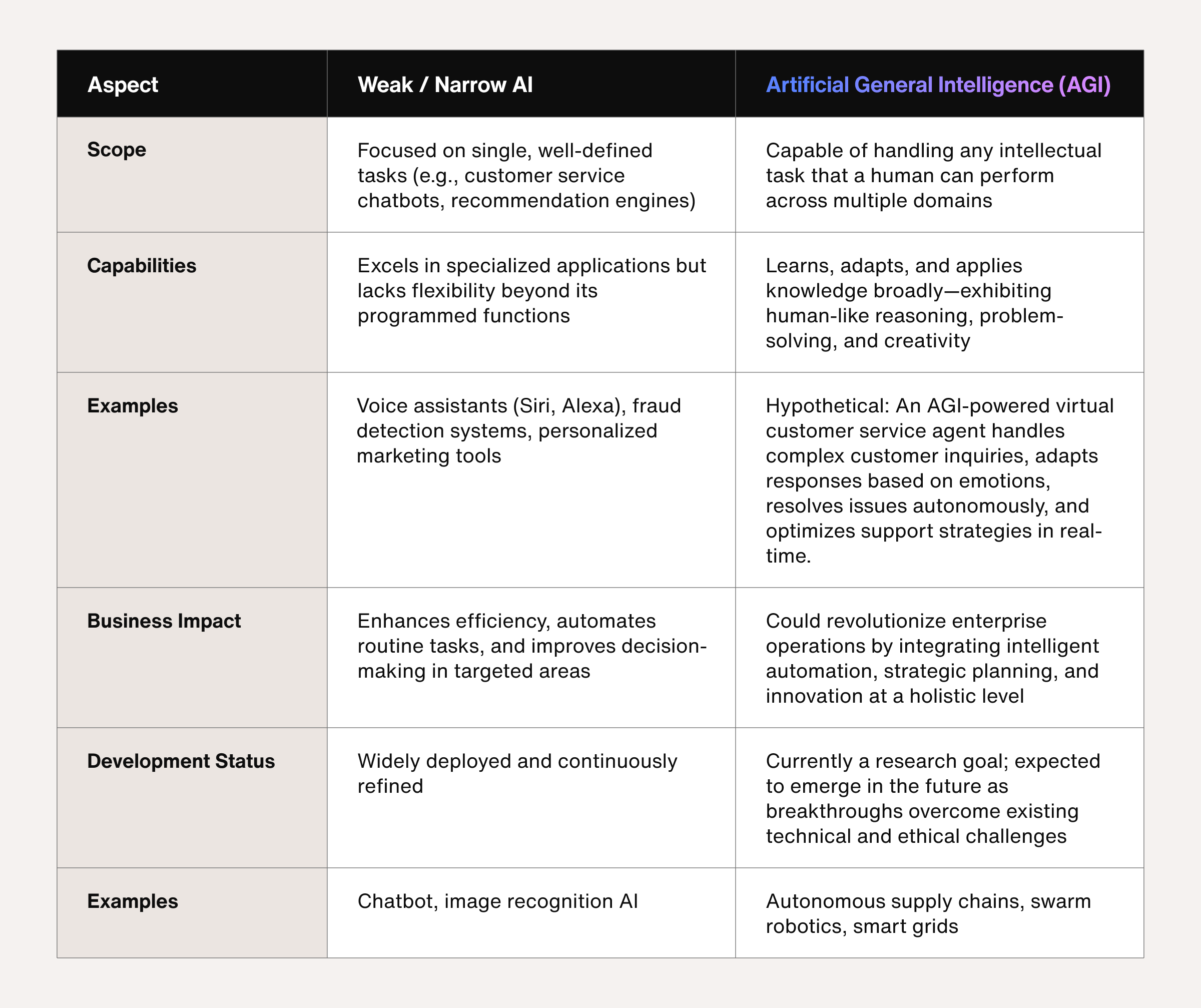What is artificial general intelligence (AGI)? A guide to AGI

Artificial general intelligence (AGI) is smarter than you, me, or anyone we know—at least, in theory. Technically, it doesn’t exist yet.
But when AGI does arrive upon the ever-accelerating wave of AI innovation, it brings with it machines that can effectively mimic human thinking without assistance. Not only will this redefine the boundaries of intelligence as we know it, but how businesses across industries approach innovation, customer experience, automation, and more.
So, you should ask yourself: When AGI finally becomes a reality, will my business be ready to harness its transformative power? Or will I be left scrambling to catch up with a rapidly evolving technology?
This guide will help you understand AGI, its impact on the AI workforce, and how to prepare your organization for a future driven by intelligent automation.
Specifically, you’ll learn:
What is artificial general intelligence (AGI)?
Artificial general intelligence (AGI) is a hypothetical form of AI designed to match or exceed human cognitive abilities. Unlike current AI technology which is limited to executing specific tasks, AGI would be capable of performing any intellectual task that a human could, including:
Make autonomous decisions in real-time without human intervention
Reason and operate across different domains seamlessly
Solve complex problems in novel ways
Adapt to new and unfamiliar situations
Learn from experience without human feedback or oversight
When will AGI arrive?
It’s one of the biggest questions in AI, and opinions vary widely. In a recent survey of 2,778 AI researchers, experts estimated that if scientific progress remains uninterrupted, machines have a 10% chance of surpassing human performance in all tasks by 2027, and a 50% chance by 2047.
Still, there’s no consensus on when or if AGI will be realized. Some believe it could take much longer than current estimates, or never happen at all. In the end, AGI demands game-changing innovations in reasoning, adaptability, and generalization that researchers have yet to solve.

Delight customers with AI customer service
Why businesses should begin preparing for AGI
You might be wondering: why think about AGI when you’re still working to harness the capabilities of today’s AI tools?
Experts like Google DeepMind CEO, Sir Demis Hassabis, have suggested that AGI’s impact will be profound:

AGI vs. AI: What’s the difference?
Artificial intelligence (AI) and artificial general intelligence (AGI) differ in their scope and capabilities. Experts refer to narrow, specialized AI as weak AI or narrow AI, while they refer to AGI as strong AI or general AI due to its broader cognitive abilities.
The AI tools available today are designed for specific tasks, and so fall into the category of narrow AI. Narrow AI technologies include chatbots, recommendation systems, fraud detection algorithms, and language models like ChatGPT. These systems excel in well-defined domains but cannot transfer their learning to new, unrelated tasks.
AGI goes beyond task-specific automation and pattern recognition of current AI. It represents a future vision where machines can think, learn, and adapt with the versatility of human intelligence.

AGI vs agentic AI
Agentic AI, which is capable of proactive and autonomous action, reasoning, and adaptation over time based on experiences, represents a step change in AI’s ability to act autonomously. That said, while AI agents more closely mimic human intelligence than any AI before it, they still fall well short of AGI in their cognitive abilities.
For example, AI agentic workflows still require considerable orchestration, monitoring, and optimization to execute tasks that humans find simple. Even vertical AI agents, which are specialized to particular industry tasks, have a long way to go before they can engage in AI workflow automation on their own.
Learn more: What is agentic AI?
Key technologies in AGI development
Understanding the breakthroughs in several AI technologies available today can help us imagine a future where AGI exists. These technologies set the stage for even more advanced AI systems.
Machine learning
Machine learning is the heart of modern AI. It enables computers to analyze data, recognize patterns, and make decisions autonomously. AGI would take this further by learning across multiple domains, adapting to new information without human intervention, and generalizing knowledge beyond predefined tasks.
Deep learning
Deep learning is an advanced branch of machine learning that utilizes multi-layered artificial neural networks to analyze intricate patterns within large datasets. Its ability to mimic the human brain's structure has driven breakthroughs in image recognition, natural language processing, and decision-making tasks. Deep learning is crucial for AGI development because it enables systems to understand and interpret unstructured data in a human-like way.
Neural networks
Neural networks are computational models inspired by the human brain. They are designed to identify patterns and relationships within data by connecting layers of processing units. By mimicking human thought processes, neural networks allow for more sophisticated decision-making.
Generative AI
Generative AI (Gen AI) creates original content such as text, images, music, or even virtual environments based on vast amounts of training data, predicting the next output in a sequence based on what came before. Gen AI plays a key role in the journey toward AGI by demonstrating the potential to produce relevant outputs in user-facing applications.
Natural language processing
Natural Language Processing (NLP) is a field of AI focused on enabling computers to analyze text, comprehend context, and even engage in conversation. AGI would take this further by fully understanding context, nuance, and intent across languages.
Computer vision
Computer vision enables machines to interpret and understand visual data. It plays a pivotal role in AGI research by replicating the visual perception essential for human-like reasoning. For example, an AGI-powered system might use computer vision to interpret medical scans to diagnose diseases with human-level accuracy and adaptability.
Robotics
Robotics combines AI with mechanical systems to create autonomous machines capable of interacting with the physical world. It is integral to AGI development as it offers a tangible platform for testing human-like decision-making, adaptability, and sensorimotor skills.

Automate customer service with AI agents
Potential AGI use cases and examples
AGI has the potential to drive innovative strategies and enhance human interactions across every facet of business. Here are some examples of how AGI could reshape industries.
Customer service
Customer service teams struggle to manage a high volume of routine inquiries while still providing that personal, attentive touch. With AGI, AI customer service systems could offer dynamic, real-time support that adapts to each customer's needs in real-time.
Imagine an intelligent AI agent for customer service that seamlessly responds to complex queries, learns from every interaction, and anticipates customer needs before explicitly stated. An omnichannel AI agent platform with AGI could integrate multiple channels—chat, email, voice, in-app—to provide consistent, personalized service at every touchpoint. It could adapt to sentiment and context in real-time, ensuring that customers receive timely and accurate support.
Cybersecurity
Current cybersecurity technologies leveraging AI typically use narrow, rule-based models designed for specific threats. In contrast, an AGI-powered system would go beyond pre-programmed responses.
AGI could learn and adapt continuously, integrating insights from diverse scenarios and transferring knowledge across different contexts. This means it could handle novel and unforeseen attacks with human-like intuition.
For example, a financial services company might deploy an AGI-powered cybersecurity platform that scrutinizes every transaction for anomalies. The platform could automatically identify unusual patterns and initiate countermeasures without waiting for manual intervention.
Ecommerce
In ecommerce, current AI solutions typically excel at isolated tasks, such as powering recommendation engines, managing inventory, or handling customer segmentation. However, these systems operate independently and rely on pre-programmed models not designed to integrate real-time data.
AGI could transform online shopping into a hyper-personalized experience, merging diverse data streams to adapt the shopping journey to individual customers to deliver a truly holistic, responsive experience.
Imagine an online store that sells hats. Customers might have to sift through a selection of hat styles, unsure which one truly reflects their personal taste. With AGI, the AI for ecommerce system could learn each customer’s unique preferences and curate a tailored collection that feels like it was designed just for them,
Finance
The financial sector thrives on data-driven decision-making, risk assessment, and market predictions. AGI in finance could redefine how businesses manage money and investments.
While current AI technologies can analyze historical data, detect fraud, and automate trading strategies, they cannot adapt to entirely new market conditions without human intervention. By leveraging AGI, financial institutions could develop systems that autonomously predict economic shifts, adjust portfolios, and optimize investment strategies with human-like reasoning.
Healthcare
Healthcare is one of the most complex and high-stakes industries, where accurate decision-making can mean the difference between life and death. Still, current AI healthcare solutions tend to operate in silos. One system analyzes medical images, another monitors vitals, and a third predicts disease risk. They cannot autonomously adapt to new medical scenarios.
AGI could make it possible to develop a centralized system capable of reasoning and adapting to entirely new medical conditions without human intervention. Imagine an intelligent system that detects abnormalities and understands their context. It might also integrate patient history, genetic data, and environmental factors to generate personalized treatment plans.
Manufacturing
In manufacturing, narrow AI tools can optimize production schedules, monitor equipment for predictive maintenance, and improve quality control. However, these tools still lack the ability to adapt dynamically to unexpected changes or generalize insights across different manufacturing processes without resource-intensive AI orchestration.
AGI could revolutionize manufacturing by autonomously redesigning workflows, optimizing resource allocation, and making adjustments without human intervention.
For example, if a sudden shortage of raw materials occurs, an AGI-powered tool wouldn’t just flag the issue. It could instantly analyze alternative suppliers, adjust production schedules, and reconfigure assembly lines to minimize downtime. It could even predict future disruptions and proactively adapt before they happen.
Marketing
There are countless AI tools available to analyze customer behavior, personalize ads, and automate outreach. Still, these tools operate within predefined rules and struggle to adapt dynamically to shifting market trends or unexpected consumer behaviors.
An AGI-powered marketing assistant could autonomously analyze vast amounts of customer data to identify emerging trends and adjust strategies. It could also predict changes in consumer behavior before they happen, proactively refining messaging and campaign approaches to stay ahead of the competition.
For example, if the AGI assistant were to detect a sudden spike in interest for a particular product, it could instantly reallocate ad budgets, tweak messaging, and optimize targeting across multiple platforms.
Real estate
The real estate industry relies on data-driven insights to price properties, match buyers with homes, and predict market trends. Traditional AI tools can assist with routine tasks like property recommendations, automated pricing, and virtual tours. But what happens when the market shifts unexpectedly?
An AGI-powered real estate tool could autonomously analyze market trends, buyer behavior, and economic indicators to optimize pricing strategies. It could also predict future demand and adjust listings and marketing efforts to attract the right buyers at the right time.
For example, if AGI detects a growing demand for homes in a particular neighborhood due to new infrastructure developments, it could instantly adjust property valuations, tailor recommendations for potential buyers, and optimize ad targeting for real estate agents.
Supply chain management
Available AI tools for supply chain management help businesses track inventory, optimize routing, forecast demand, and more. However, due to their reliance on historical data and fixed algorithms, they’re incapable of adapting to unpredictable disruptions or making autonomous strategic decisions.
With AGI, supply chains could become fully adaptive, self-optimizing systems that adjust to shifting market conditions, weather disruptions, and supplier issues. Imagine a supply chain that instantly reroutes shipments when a key distribution hub experiences delays or secures alternative suppliers the moment it detects a potential shortage.
That level of intelligence would eliminate inefficiencies, reduce costs, and ensure businesses stay resilient in an unpredictable global economy.

Boost CSAT with proactive AI customer service
Technical and ethical challenges of AGI
Several significant technical and ethical challenges must be overcome to create AGI systems with human-like capabilities. Until then, AGI remains an ambitious goal rather than a practical reality.
Limitations of narrow AI
Narrow AI solutions operate within defined scopes and lack the ability to apply knowledge beyond programmed functions. For example, a fraud detection AI can identify suspicious transactions, but it cannot analyze customer sentiment or optimize marketing strategies. Developing AGI means creating a single, unified model that seamlessly integrates and transfers learning across diverse tasks.
Data and computing demands
AGI systems must process a wide variety of information in real-time. They need robust infrastructure and advanced algorithms to capture the intricacies of human thought. Without investing in energy-efficient hardware and sustainable data centers, it’s hard to scale AGI systems without facing increased operational costs.
Ethical challenges
AGI must be developed with robust ethical frameworks and safeguards in place. How do we ensure that an AGI system treats everyone fairly? How can we guard against biases hidden in data? How do we maintain accountability and transparency as these systems become more autonomous? Considering and answering these questions is essential because it affects public trust in both our technologies and the organizations that deploy them.
How to prepare your business for the future of AGI
Preparing your business for the future of AGI is about more than just adopting new technology. It’s about building a foundation that allows your company to adapt and thrive as AI evolves. It’s also a strategic move that ensures you stay ahead of competitors.
Here’s how you can start preparing today to position your business for long-term success.
1. Assess your current use of AI tools
Start by evaluating how your business currently uses AI. Understanding your strengths and gaps will help you determine where AGI could provide the most value in the future. For example, you could begin by auditing your current AI tools to understand their capabilities and limitations.
2. Invest in scalable AI infrastructure
AGI will require significant computational power, real-time data processing, and adaptable systems. Investing in cloud computing, AI-ready data architecture, and automation-friendly workflows ensures your business can seamlessly integrate AGI when it becomes available.
3. Prioritize continuous learning and workforce development
AGI will change the nature of work. Prepare your team by offering AI education, training programs, and upskilling opportunities. Also, encourage employees to learn about AI-driven decision-making, automation, and emerging trends so they can adapt alongside technological advancements.
4. Develop ethical AI policies and governance
As AI becomes more advanced, ethical considerations around fairness, transparency, and accountability will be critical. Establishing clear guidelines for AI use in your business helps ensure compliance with emerging regulations and maintains trust among customers and stakeholders.
5. Start experimenting with advanced AI solutions
While AGI doesn’t yet exist, businesses can start preparing by integrating more advanced AI technologies, such as multi-agent systems and generative AI. These technologies provide a glimpse into how AGI could function in the future.
6. Stay agile and adaptable
The path to AGI is uncertain, and breakthroughs may come unexpectedly. Businesses that remain flexible, regularly update their AI strategies, experiment with emerging technologies, and invest in continuous learning will be better prepared to seamlessly integrate AGI when it becomes available.

Delight customers with AI customer service
AGI is the one-day future of AI
AGI represents a theoretical endpoint for AI technology, an aspirational rubicon that once crossed will transform industries by equipping machines with human-level intelligence. In this fast-approaching potential reality, intelligent agents will operate on behalf of businesses and consumers across every facet of life—coordinating, transacting, even negotiating in alignment with the preferences and goals of their owners. In other words, AGI will enable the AI-agent-to-agent (A2A) economy and the future of the AI workforce.
If you’re looking to build AI agents before the arrival of AGI, Sendbird can help.
Our robust AI agent platform makes it easy to build AI agents for any use case on a foundation of enterprise-grade infrastructure that ensures optimal performance with unmatched adaptability, scalability, or security.
If you want to learn more about the future of AI, you might enjoy these related resources:










